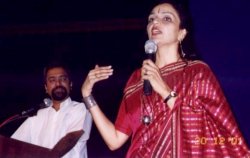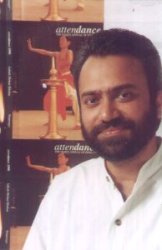
|  |

|  |
Q & A: Audience Artist Interface 21st Natyakala Conference - 2001 Chennai, India DEC 20, 2001 Ashish Khokar (Bangalore) "History of Choreography in Indian Dance" Feb 2002 Ashish Khokar spoke on 'The History of Choreography in Indian dance", interspersed with a slide show and a 20 minute documentary he had made for Doordarshan called MISHRAN which featured Rituals by Astad Deboo, Parikrama by Sriram Bharatiya Kala Kendra, Kabbadi by Kathak Kendra, nava rasa abhinaya by Geeta Chandran and Vivaldi by Daksha Sheth.   For that film of 20 minutes, you probably shot over 200 hours of footage? Yes. 'Mishran' opens with Astad's sequence 'Rituals', which was done in that nice light. I know how hard Astad worked with us. It's a 10 minute edited version, which took us more than 10 hours to shoot. I still have a court case with Delhi police because we shot from 10 at night till 3 in the morning. It was in an area where the MPs and half of Delhi's politicians stay. Somebody complained, so the police said we couldn't have the loud music running after 11pm. The producer's still answering those police enquiries but we have better things to do! That shot with Astad took us almost 10 sequences. Astad never eats before he performs, so he didn't eat the whole day, he didn't eat the whole night, and he still loves us! He's a wonderful person. The crane shots are very important and that was a circle of real candles burning. Every time one candle would go off, we had to continue with a new round of candles. The halogen light, which is 10,000 watts, burns off every half hour, it costs 20,000 rupees. It's not a matter of money; it's a shot we love. It's a sequence that Astad was very sweet to share with us. He never charges any money, just getting here from Bombay. Such an artist is what South India's made of. All the pieces that we saw in the film are what we identify today as contemporary dance and creative dance. How would you position a tisra alarippu like what you had Valli do (in another project), in terms of choreography? Very difficult situation especially when you're filming dance because you are reducing or extending it to another medium to begin with. We had this situation where Valli features on this episode on nritta and that's where alarippu fits in because each episode is made on a subject matter-music in dance, make-up in dance, technique in dance, abhinaya in dance. I was asking Madhavi Mudgal in Delhi this question about Odissi, "From the art of a solo when you extend it to a group, what's the difference?" The sum is the energy is transformed partly, it multiplies. If a soloist is doing a piece, and 4, 5 or 7 people then do it, then the energy levels are much higher. It seems to an observer that the whole environment is more surcharged. The whole energy that was hers gets distributed; of course the pristine beauty of the alarippu stays. Watching Kathak Kendra do the kabbadi movements, you said, 'This is choreography'. What did you mean by that? Because it is reducing a daily activity like a game of kho-kho or a cricket match or any of these activities and using the grammar of a classical form like Kathak, trying to do it in a limited space in terms of a stage or whatever space is marked. It's the real test of a genius like Birju Maharaj, because it's just an everyday activity of kids playing on the street but to compose it in a set language of Kathak or any other form and then trying to hold it together for the purpose of filming it, that's the real test of a genius in terms of choreography, to reducing or limiting or setting the medium. V A K Ranga Rao: This game of kho-kho? Kabbadi. Many of the pieces, particularly as on film have been done in films earlier. Shriram Chitra did it in a film called 'Anpadh' around '51-'52 ('Mausam hai tanda tanda'). I don't remember who did the choreography, but it was done. The playing of chess in an earlier film 'Pukar' was repeated many decades later in 'Shatranj ke khiladi'. You say that when something very complicated is choreographed, that is choreography. You can call that better choreography. Whatever, there were artists who left a lot of leeway for themselves to improvise their creative efforts at that time. Isn't that choreography? As I've stated in my paper, film dance or dance in films is too extensive a subject to cover per se in a 45-minute framework. I've already stated that dance in films and solo dance within the tradition of Indian classical is something I will not be focusing upon within the spectrum of this session. That is the preamble, which I've stated in my paper. I've also stated at the outset that it's a whole subject and who better than you to speak on that? If there are any value judgments in that, it's only through the point of view of people who feature in these episodes for the purpose of demonstration. The beginning and the end is absolutely wonderful, the music and the music instruments are undoubtedly Indian. But the bits of western music, like ballet and the merging of Indian forms, how does it blend? That work is Vivaldi's 'Summer', a famous tune in western composition. Daksha Sheth has used that music score to create her work, which is a mix of Kathak and leaps of western ballet. That's the choreographer's interpretation of the work and the theme; it's a homage to Vivaldi. Some of the movements are reminiscent of the nayaki waiting to go and meet her lover, like the combing of her hair, certain elements she has taken from the Kathak style. That's true. While that happened, we were waiting for Jayalalitha to cross our way! It was shot in Neelankarai and Palavakam (in Chennai) stretch by the beach and Jayalalitha was still the Chief Minister 5 years ago and her cavalcade crossed ours; we were not allowed to go on that road. One camera reached, the second one died, so we shot with one camera in rain and thunder. In the film you showed us, you called the items modern Indian dance. It was 'Dance Today'. Writers like us have to be careful when we say these things. All of it is not modern, because Kathak is not. So we called it 'Dance Today'. 'Mishran' was done for Doordarshan, it means amalgamation. These are just instances of choreographic possibilities. A major area overlooked was the 20's and 40's and later, the direction modern dance was taking. Closer to home, a little after independence, we were trying to re-invent, trying to relocate and go back and pick up the threads. Somewhere you compartmentalized tradition and modernity. I really wonder if we can think like this. I feel there's no such divide. In the case of Chandralekha, once she started on what is labeled as modern or contemporary, she never went back to what you would call a traditional performance. I think in Chandralekha's case, you are mistaking her positioning her ideology with dance. They are inseparable but I'm changing it for the point of view of dance history. I'm really not interested in the positioning aspect because she has gone beyond tradition, because she has mastered the tradition-they are two different things. Regarding innovation. In the period of 20's to 40's, I clearly said India was still a colony. Uday Shankar was still in Paris and we were trying up to the 40's to revive our traditional classical forms. There was no question of modern dance other than what Uday Shankar and his disciples were doing. So we had absolutely nothing to do with modern dance in this phase. That dance was modern for that period because it was revival. At the same time, the classical tradition was being revived. That's the phase I mentioned as between 40's and 60's. Speaking of Chandralekha, since the conference schedule over the week did not feature the choreographer, well known for her contemporary dance interpretations, the convener Anita Ratnam decided to answer the unspoken question! Anita: It was sometime in August (2001), that I sent out a letter to Chandralekha wanting her to be the only person on the last day, because she has a very wonderful sense of awareness put together. The video presentation of her work is about an hour and 15 minutes and it traces her whole evolution and her ideas of dance, which is very relevant to this conference. I did speak to her too. She was full of travels to Chicago, to the US and Canada at that point and she said "Yes, I'll think about it when I come back." I'm sorry she couldn't be here, but an invitation did go out. Even though I'm not the convener next year, I think that an audience like this should see this technological compilation of Chandralekha, her work and Chandralekha over the years. Q & A: Audience Artist Interface 21st Natyakala Conference - 2001 |